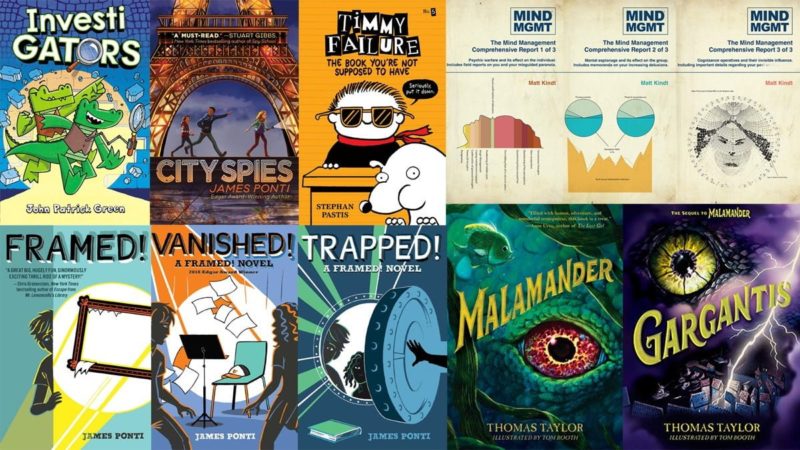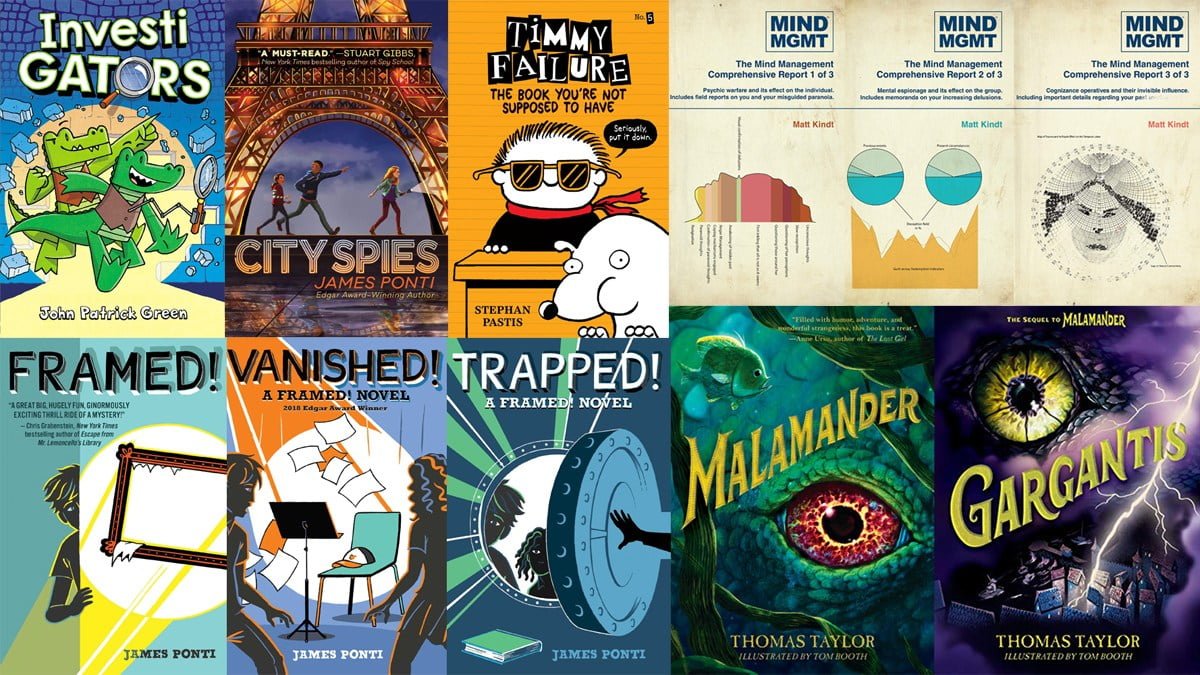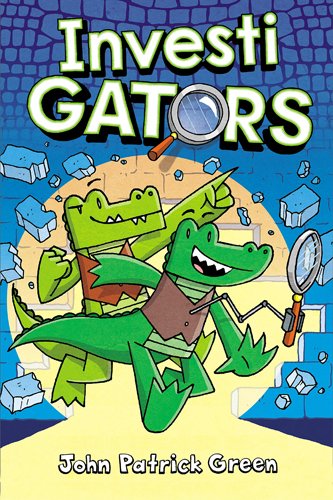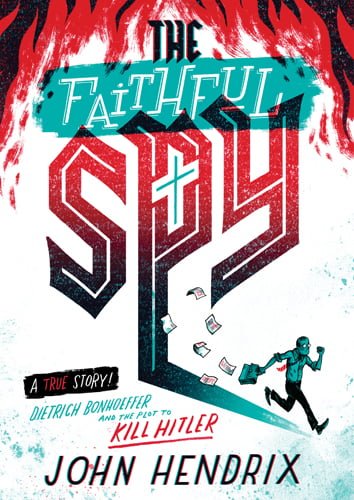Today’s column has kid spies and kid detectives, alligator spies, psychic agents, and giant fish creatures. Espionage, investigations, conspiracies, and legends! If you like puzzling out clues and tracking down secrets, here’s a list for you.
InvestiGATORS by John Patrick Green
Mango and Brash are InvestiGATORS, agents of S.U.I.T. (Special Undercover Investigation Team). It’s their first mission together (after some disaster befell Brash’s first partner), and they have two mysteries to solve: the disappearance of world famous cupcake chef Gustavo Mustachio, and an explosion at the Science Factory. This kid-friendly comic book is filled with goofy jokes and absurd humor—for instance, the fact that a fake mustache on an alligator is enough to fool the baker’s assistant that Mango is Chef Gustavo. There’s also a nod to John Green’s TeenBoat, with Doctor Copter, a doctor who turns into a news helicopter whenever he hears anything newsworthy. And there are plenty of other references thrown in for older readers (like the names Mango and Brash, for instance) that I’m sure will just fly over the heads of kids.
The Framed! Trilogy by James Ponti
I had a copy of Framed! in my stack for a few years; my daughter had read it a couple of times and told me she enjoyed it, but I hadn’t gotten to it until recently. After reading the first book, I picked up the two subsequent books in the trilogy at the store so I could see how the story continued.
Florian Bates is like a middle school Sherlock Holmes: his attention to the details lets him piece together the big picture. He calls it T.O.A.S.T.: the Theory Of All Small Things. (Fun fact: the first book, Framed!, has the subtitle “A T.O.A.S.T. Mystery,” but by the second book they decided the series was called Framed! and not T.O.A.S.T.) For Florian, it’s easy to get misdirected when you look at the big, obvious things, but the truth is supported by the small details.
The three stories include an art thief (Framed!), dealing with middle school pranks and a missing musician (Vanished!), and investigating a Russian spy ring (Trapped!). During the course of the first book, Florian and his best friend Margaret end up working for the FBI—they’re kept a secret, of course, but they work closely with a small number of agents to solve cases. There are also some interesting threads outside of the main mystery that can expand the reader’s world a little: Margaret is adopted and is interested in finding her birth parents, so we learn about what that’s like. In Vanished!, the kids meet a famous young cellist from China, and learn a little bit about complex political dynamics involved in his presence in the United States. In Trapped!, Marcus has been accused of a crime, and the kids experience firsthand the difficulty of investigating somebody you care about.
The three books all follow the same format: it starts with Florian in the middle of a situation, when he finds a clue that “changes everything.” And then we jump back to the beginning of the story, and find out how he got into that situation to begin with, until we catch up to the opening scene. Finally, the rest of the story plays out, and we see how he uses that clue to solve the mystery—though there’s often still a good bit of book left after that opening situation, too.
The books are fun, even if they’re improbable, because the best part of reading mystery books is trying to piece together the clues along with the character.
City Spies by James Ponti
And here’s a new book (coming in a couple weeks) from the author of the Framed! trilogy, this time across the pond. This group of kids works (covertly, of course) for MI6, but they’re even a secret from most of MI6. (Yes, Ponti seems to have a thing for this scenario.) This time, though, the kids aren’t all brilliant detectives, but they’re a spy team with different skills: hacker, cryptography, and even street magic. Each one uses a code name based on the city they’re from: Paris, Rio, Sydney, and I like that there are kids from several different backgrounds.
The team is headed up by a man named Mother (code name? real name? I don’t know), who had been betrayed on a mission and left for dead. He has since assembled a team of kids from around the world, many of them from troubled backgrounds of some sort. The book jumps back and forth in time a little, telling the story of their newest recruit Sara (aka Brooklyn) and her first mission, while also filling us in a bit on how other kids joined the team. The latest mission involves a youth climate summit in Paris and Stavros Sinclair, the reclusive but brilliant head of Sinclair Scientifica—and a potential target for many interested parties. The kids are there to keep an eye on him, with a side mission to hack into the company’s servers to look for evidence that Sinclair has been working with a terrorist organization.
Much of this book is about getting acquainted with the team: both the reader and Brooklyn are learning how things work. It’s a fun mix of spy technology and subverting cliches about spy technology—sure, Brooklyn can make some impossible computer hacks, but also Mother drives an old station wagon that doesn’t have any hidden secrets. I’m not sure if there will be more books to follow, though it’s certainly a good setup for future missions. My only complaint is the title, which is also the name that the team comes up for themselves: “City Spies” (chosen in part because the members are named after cities) just doesn’t have much of a ring to it for me, and it’s hard to see why a bunch of tweens and teens would get excited about it. But the story itself is exciting and worth a read!
Malamander and Gargantis by Thomas Taylor
Robin Brooks wrote about Malamander last year when it was released, and I finally read it for myself, along with the upcoming sequel, Gargantis (due in May 2020). Both books take place in the town of Eerie-on-Sea, a place of myths and mysteries. Herbert Lemon is the official “Lost-and-Founder” of the Grand Nautilus Hotel, and is in charge of trying to track down owners of lost items. When Violet Parma arrives one day, sneaking into the basement where found items are stored, it dredges up some weird history: her parents vanished 12 years ago in pursuit of the legendary fish-man, Malamander, and she has returned to figure out what happened to them. Herbie and Violet piece together clues to figure out what parts of the Malamander myth are true and what parts could easily be explained away—and local author Sebastian Eels seems to take particular interest in their findings.
Gargantis is the sequel, and features another set of myths, this time about a monstrous flying fish named Gargantis that brings devastating storms to the town. The fishermen of Eerie-on-Sea have a lot of old sayings about Gargantis and Saint Dismal, the town’s first fisherman. Herbie and Violet are determined to get to the bottom of it before the town is torn apart—both by the storms and by the fight for ownership of a mysterious glowing bottle that was discovered on the beach. There’s also the mystery of Eerie Script, a code that is found inscribed on the bottle and is linked to Saint Dismal. I’ll admit that I didn’t manage to crack the code myself, but clever readers may try to figure it out before the solution is revealed.
These were both fun to read, and I look forward to my next visit to Eerie-on-Sea!
Timmy Failure 5: The Book You’re Not Supposed to Have by Stephan Pastis
I’ve fallen behind on the Timmy Failure series: Pastis is up to book 7 already (and a movie streaming on Disney+!), but I’ve only recently read the fifth book, which came out (checks copyright page) four years ago?! I don’t know how that happened. Anyway, in case you’re not familiar with Timmy Failure, he’s a kid detective with a pet polar bear named Total (thus the agency’s name: Total Failure). The difference between Timmy and most other kid detectives, though, is that Timmy is actually clueless. He thinks of himself as the greatest detective in the world, but in reality, he’s just a string of problems waiting to happen. And Pastis, the creator of the Pearls Before Swine comic strip, has a lot of fun putting Timmy in ridiculous situations.
In this volume, Timmy has been banned from detective work, due to the events of the previous book. His mom wants him to focus on his schoolwork instead, and has also signed him up for piano lessons. He can start detective work again in six months, maybe a little earlier with good behavior. But, of course, that’s not how Timmy works. The setup this time includes Timmy’s teenage girl cousins who come to stay for a while, the mysterious disappearance of his best friend Rollo, and a secret office location (i.e., a display shed at Home Depot).
If you’re looking for a kid detective story where the kid does not put together all the pieces by the end of the book, this series is for you. The fun thing is: there is an explanation for Rollo’s disappearance, but you have to ignore Timmy’s hunches to figure it out for yourself.
Mind MGMT by Matt Kindt
I recently got to play a board game prototype called Mind MGMT (my review was published last week), which was based on this comic book series. I’d heard of it before, but had never read it, and the game’s theme was intriguing enough that I decided to give it a try. I was lucky to find used copies of the three-volume omnibus edition at the bookstore, and plowed through three and a half years of issues in a couple of weeks.
Here’s the setup: Mind MGMT is a secret government agency based on various types of psychic abilities. Some agents use mind over matter to make themselves practically immortal. There are various forms of mind control, from using subliminal messaging in advertisements to influencing emotional states, and the agency uses these to further their agenda in other countries.
At least, that’s how it used to be, before a powerful agent named Henry Lyme went haywire and caused an entire city to fall into chaos. The agency was disbanded, memories were erased—but now some are trying to start the agency up again, and others are trying to stop it.
The story is captivating, and Kindt is able to take a mashup of conspiracy theories and off-the-wall ideas and weave them into a world that is unsettling and convincing. I’ll admit that I’m not always a fan of Kindt’s drawing style: the people’s faces have strange proportions and the drawings can feel a little too much like sketches at time, even with the watercoloring on top of it. However, I do love his concepts, which are brilliant. In much of the story, the comics are illustrated on some sort of official paperwork template, which includes the Mind MGMT training manual in the marginalia. Reading these lines in concert with the ongoing story gives you a fuller picture of the world, and you’ll see lots of fascinating parallels. There are also fake advertisements with creepy messages (some hidden, some not).
It’s easy to see why the series is so well-regarded. If you like conspiracies, spies, and superpowers, it’s definitely worth a read!
The Faithful Spy: Dietrich Bonhoeffer and the Plot to Kill Hitler by John Hendrix
Speaking of conspiracies, this one is the only non-fiction book in today’s stack, a combined comic-and-prose book aimed at middle schoolers from a couple years ago. I’d known a little about Bonhoeffer before but only peripherally, so I’m learning a bit more about him, along with the relationship between German churches and the Nazi movement leading up to World War II. The book follows Bonhoeffer’s life and theology, particularly as he wrestles with the question: would it be moral to kill Hitler? It also traces the history of Germany, from its defeat in World War I through the end of World War II, showing how circumstances and choices created an environment where the Nazis could rule.
The writing does seem to approach the story from a Christian perspective, showing how Bonhoeffer’s faith in God are tied to his courageous actions, including his involvement in three failed attempts to assassinate Hitler. Some of the metaphors get a bit colorful, but it’s still a good overview of this life. And while it’s never explicitly stated, it does feel like Hendrix sees a parallel between Hitler’s rise to power and our current politics: “recent history has shown humanity has not been permanently vaccinated against tyrants.” It’s not just a historical account, but also a cautionary tale.
My Current Stack
I got two comic books in the mail last week that were both excellent: Department of Mind-Blowing Theories by Tom Gauld, and Dragon Hoops by Gene Luen Yang. Tom Gauld’s comics are always a treat, and this one is a collection of science-themed comics. Gene Yang is the author of several graphic novels, but this one is non-fiction and his most personal yet—but it’s also about basketball. I’ll tell you more about it soon, but it’s a fantastic read.
I also read Providence, a sci-fi book by Max Barry, another favorite author of mine. It’s about an interstellar war against an alien species, and the crew aboard the Providence, an enormous battleship that is largely driven by AI. Some intriguing themes about war and decision-making. More about this one soon, too!
Next week I’m hoping to have some books for Women’s History Month, so stay tuned!
Disclosure: I received review copies of the books in this column except where otherwise noted.












